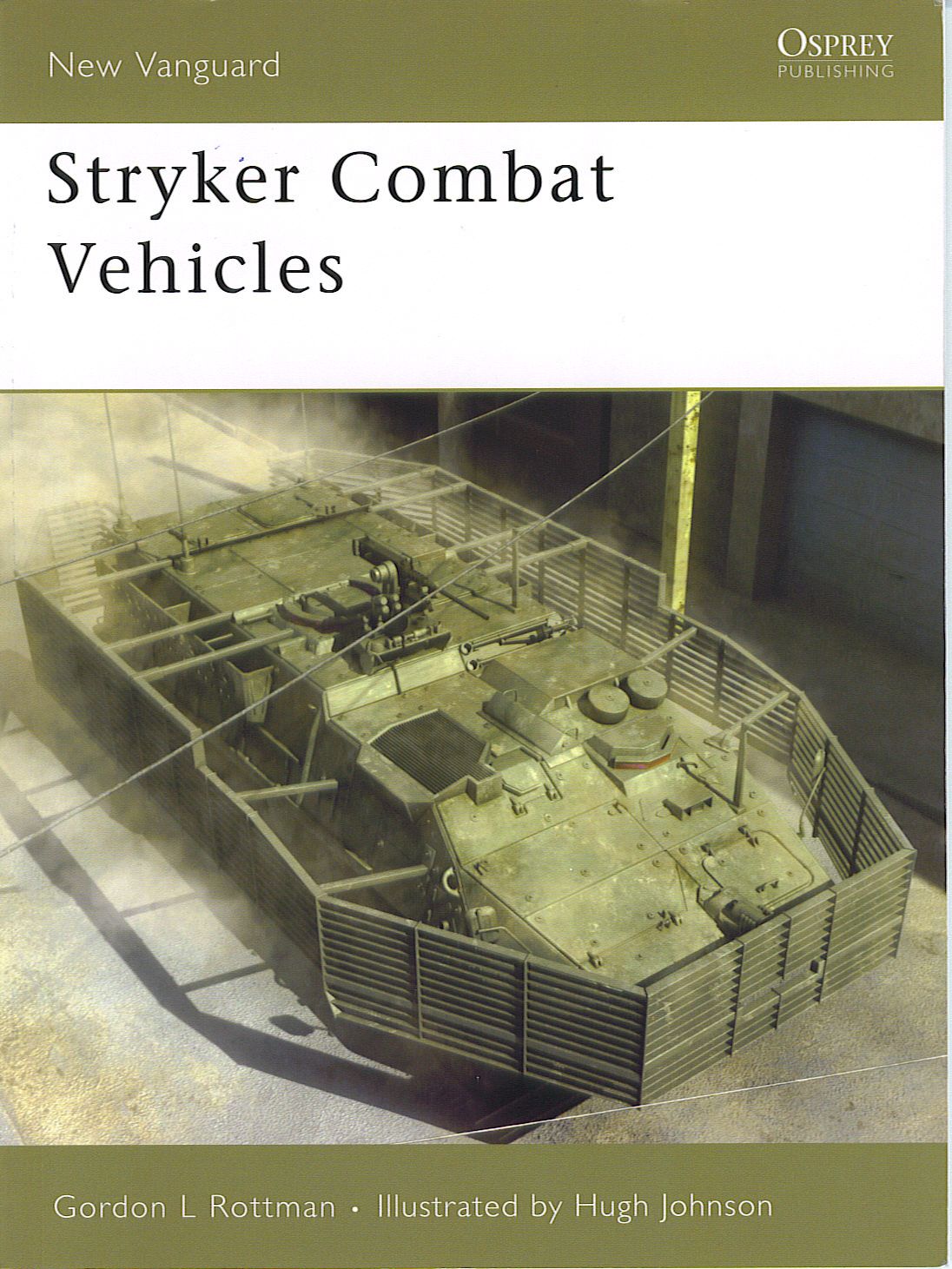|
| Please Support our Sponsors | ||||
 |
 |
Book Review of
“Stryker Combat Vehicles
Review By Patrick Keenan - Editor
(First Published at Armorama)

Basic Item Information
|
Title |
Stryker Combat Vehicles |
|
Author, Editor and/or Illustrator |
By Gordon L. Rottman; Illustrations by Hugh Johnson |
|
Publisher |
Osprey Publishing - New Vanguard Series #121 |
|
ISBN/Stock Number |
ISBN 1-84176-930-4 |
|
Subject |
Modern AFV |
|
Media |
Soft Cover Book |
|
Number of Pages |
48 |
|
Number/Type of Photos and/or Illustrations |
(38) B/W Photographs, (2) B/W Illustrations; (15) Color Illustrations. |
|
Text Language |
English |
|
Retail Price |
$17.50 USD (9.50 British Pounds Sterling) |
|
Reviewer |
Patrick Keenan |
|
Review Date |
July 18, 2006 |
Review Summary*
|
Review Type |
Normal Read |
|
Basic Positive Features |
Considering the number of pages, the book is an outstanding overall reference on just about every aspect of the Stryker; Including history, variants, combat use, tactics, etc. |
|
Basic Negative Features |
The author does not provide any information on the subject of vehicle markings. The only help provided with this topic is via a few of the photographs. |
|
Overall Rating |
4.4 of 5.0 |
|
Accuracy of Information Rating |
4.5 |
|
Editing Of Information/ Text Flow Rating |
4.5 |
|
Photo and/or Illustration Quality/Selection Rating |
4.5 |
|
Usefulness as Reference |
4.5 |
|
Quality of Print Medium Rating |
4.0 |
|
Recommendation |
Highly Recommended |
* For information regarding the review terms, grading scale, etc. please go to the WarWheels Review FAQ/Key
Photos
___________________________________________________________________________________________________
Detailed Review
|
Book Content |
|
Most anyone who has read two or more Osprey books can probably attest to the fact that each book is totally different in quality or usefulness because each is authored by a different person. I personally believe that most (if not all) Osprey books are at least decent in quality. However, there are some that are just plain better than others. This statement reminds of an old proverb I once heard. It is, “There are no bad beers; but there are some better than others”. Since I feel that cliché does apply to the Osprey series of books, to me the “Stryker Combat Vehicles” is the equivalent of a top notch Pilsner. I can honestly say that as an armored car/ wheeled fighting vehicle aficionado, I was looking forward to the release of this book and that I was very happy I was given the opportunity to review it. I was not disappointed in the least. The book’s information content is arranged in the following order:
I believe that by listing the book’s information subject layout above, that should be fairly sufficient to give most people a very good idea of the coverage and scope of this book. However, I do think it would be useful to make a few comments to clarify some points that might not be evident by reviewing the subject headers. First, the “Wheeled Light Armored Vehicles” section covers not only the armored cars/wheeled fighting vehicles used in the past by the US Military, but it does briefly expound on the tactics and roles of those vehicles as well. It does also touch upon the traditional lack of use of wheeled fighting vehicles by US forces. Second, the “Adoption of the Stryker” section, describes the reasons why the Stryker Vehicle, the creation of new types of US Army units and the resulting tactics, were developed and created. Third, the “Stryker Described” section outlines many of the basic features inherent in a majority of the variants in the vehicle family as well as the basic capabilities of them too. Fourth, the “Stryker Variant” section describes and gives a brief summary of the different uses, features and capabilities of all of the operational and planned variants of the Stryker family of armored vehicles. The variants described are:
Fifth, in the “Controversy” section, the author describes at length all the perceived and real difficulties encountered with the development, procurement, evaluation and use of the Stryker vehicles. Normally such a section would not be present or necessary in a book such as this. However, some experts believe the Stryker to be one of the most controversial combat systems ever developed by the US Military. Therefore, due to this unique situation with the Stryker, in my opinion this section is a welcome addition. Sixth, the “Stryker Brigade Combat Teams” section describes the newly developed US Military unit created to most effectively and efficiently use (some believe) of the new Stryker family. Finally, the “Combat Debut” section describes actual combat engagements experienced by the Stryker crews and vehicles. It appears that the Stryker has done an admirable job in completing the tasks assigned to the men using it and protecting them adequately while doing so. |
|
|
|
Accuracy of Information |
| The accuracy of the information provided by the author is very good. Mr. Rottman was a long-serving member of the U.S. Army, including time served as a weapons specialist. He uses his personal experience and wisdom derived as a veteran to great effect. He has also uses top-quality sources such as the US Military and the vehicle manufacturers [specifically General Dynamics Land Systems (GDLS)]. |
| Editing of Information/ Text Flow |
|
The text flow of the information (e.g. the writing ability of the author) provided is excellent. Mr. Rottman is a very good writer in that he is very good at conveying complicated information succinctly and effectively. I found the book easy to read, extremely informative and enjoyable. The information provided is in what I consider a very good format. The format is very logical and totally understandable to even the novice hobby modeler or vehicle enthusiast. Basically, it makes perfect sense to me how the author presents the information so that the reader does not have to keep on skipping back and forth throughout the book so as to figure out what is going on. The information builds upon itself as the book goes on. To me, the flow of how the information is formatted or presented by the author can take away from the quality of the information provided by him/her, if not done correctly. Mr. Rottman does an admirable job of keeping us on target. One of the general thoughts I had when reading this book is that it was ‘efficient’. What I mean by that statement is (to me), the book gave just the right amount of information for each subject topic. Sometimes, when reading a book, I feel that one subject was covered too much, while other subjects were not covered enough. That was not the case with “Stryker”. I felt that Mr. Rottman provided an adequate amount of information about most every topic, without over-covering them or neglecting any of them. To me, the coverage of each main subject topic was consummate to the importance of the information. |
|
Photograph and/or Illustration Quality and Selection |
|
Most of the photographs Mr. Rottman provides are not unique or hard to obtain since they were provided to him by accessible sources such as the US Army or GDLS. However, the selection of photographs he chose and their quality are excellent. The selection of photographs which the author has provided in the book is outstanding. The photographs cover just about every imaginable angle of the actual vehicle and we get nice photos of each Stryker variant. Plus, the selection of photos provided of operational Stryker combat units is impressive in its number. In terms of quality, the US Army and defense contractors have a lot to gain or lose with quality “PR” (public relations), so the photographs they employ are usually stellar. These are no exception in terms of the quality of the images and the excellent setting of each photo. The illustrations created by Hugh Johnson are outstanding as well. His artistic talent is evident in the quality of each picture. He also provides illustrations of each variant of the Stryker vehicle as well as a very nice “cutaway” picture showing the main interior features of the Infantry Carrier. |
| Use as Reference |
|
Obviously, Mr. Rottman’s book about the Stryker is not the end all tome on the subject. There is much for all of us to learn and information is only becoming available. However, with that being said, this reference is exceptional in value and usefulness in a book of this smallish size. There is a lot to it! This book covers just about every aspect, and then some, of the Stryker vehicle without neglecting most all of them. In my opinion, the author does a great job with such little space available. Like I said before, this book is efficient. The only negative aspect of this book is the lack of vehicle marking information provided. The author does not provide any information on vehicle markings, yet he goes in depth in terms of which specific US Army Units employ the Stryker. To me that point indicates the US Army did not limit him in this subject due to troop security or intelligence reasons. The only information provided in the book on markings is via a small number of photographs which show such markings. |
|
Quality of Medium |
|
This soft cover book is “typical” of Osprey Publishing’s format. If you’ve seen one Osprey Book, you’ve seen them all. Assuming you haven’t ever seen an Osprey series book, the soft cover media is of a decent quality which facilitates fairly frequent use/reading of the book. Obviously, all soft cover books suffer from the fact that they don’t hold up as well as hard cover books. However, Osprey does produce fairly sturdy books when compared to other soft cover publishers. |
| Conclusion |
|
This book is an exceptional value for the money. The scope of the book and the amount of information provided in this smallish book is of an exceptional level. This book is a must have if you are at all interested in the Stryker in specific, or armored cars, wheeled fighting vehicles, military vehicles used by US forces in Iraq, etc, in general . Even if you are not at all interested in these types of information, it would still be a great addition to your reference library. Highly Recommended. Thanks to Osprey Publishing via Vinnie Branigan at Armorama for giving me the opportunity to review this book. |
| Copyright: Patrick Keenan - July 18, 2006 |